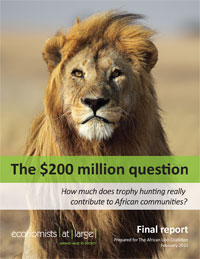Advocates for the African trophy hunting industry invariably claim that hunting revenues provide benefits to rural communities. Responding to calls to list African lions on the US Endangered Species Act, Safari Club International officials stated:
Hunters and hunting actually benefit Africa’s lions — as well as its humans. Revenues from hunting generate $200 million annually in remote rural areas of Africa. (Rudolph and Hosmer 2011)
Analysis of literature on the economics of trophy hunting reveals, however, that communities in the areas where hunting occurs derive very little benefit from this revenue.
How much revenue reaches communities?
We‘re more closely allied with the photographic operators than the hunters. They are finishing off the wildlife before we‘ve had a chance to realize a profit from it. Hunters don‘t recognize us; they only recognize the government …25 percent of hunting fees goes into the ‘hole’ at the district. We‘re supposed to get 5 percent: we don‘t even see that. (Sachedina 2008, p152)
Research published by the pro-hunting International Council for Game and Wildlife Conservation and the UN Food and Agriculture Organisation, supported by other authors, finds that hunting companies contribute only 3% of their revenue to communities living in hunting areas. The vast majority of their expenditure does not accrue to local people and businesses, but to firms, government agencies and individuals located internationally or in national capitals. As the quote above demonstrates, expenditure accruing to government agencies rarely reaches local communities due to corruption and other spending requirements.
How important is the trophy hunting industry?
Trophy hunting advocates present the industry as large, citing figures such as $200m in annual revenue. But in the context of national economies, the industry is tiny, contributing at best a fraction of a percent of GDP. Nature based tourism does play a significant role in national development, but trophy hunting is insignificant. Across the investigated countries, trophy hunting revenue was only 1.8% of tourism revenues.
Where does the $200m estimate come from?
Rudolph and Hosmer (2011)’s $200m figure is based on Lindsey, Roulet and Romanach (2006), a study based on weak sources and methodology. $100m of this estimate is based on an unpublished study by the Professional Hunters Association of South Africa. Estimates of expenditure in several other countries are based on personal communication with safari companies and other unverifiable sources. The $200m estimate should be used with caution.
Would a listing of lions on the US ESA impact communities or the African economy?
A study by hunting advocates, Lindsey et al (2012), has suggested that reduced lion hunting would have minimal impact on the financial viability of trophy hunting. Even this study has been found to overstate the significance of lions to the industry. The industry is primarily driven by hunting of buffalo and plains game such as antelope.


I started writing and there is no way I can tell in a few sentences how I feel about this. this is one of the most despicable acts. Of course I am appealing for the animals but I am concerned about the type of people that are involved in this. they walk the streets. It’s savagery. Lorraine
Wheres our humanity gone? Our wildlife is disappearing faster than it can recover. Africa is one of my most dream places to visit to see Lions in the wild along with all of the other animals it has on its planes. But im worried the by the time I can get there, the animals I really so dearly want to see will be endangered or worse extinct. They are not made on a production line, who’s right is it for humans to use these incredible animals as a toy in a game. Its frustrating to be constantly confronted with a world that gets its enjoyment from animal suffering.
Most civilised people will be appalled and sickened by the like of Walter Palmers actions, but until the authorities use the full extent of the law to prosecute and impose tough harsh penalties, then these warped flawed human beings will continue to persue hunting (legal or otherwise) under the guise of sport!! The demand has to be tackled first and then the supply will dwindle. No Demand-No Supply!
I have become so disgusted by the violence and barbarism directed at wildlife, that I look closely at anything I buy, and any place that I travel to. We went to Costa Rica this year.The UK or Botswana next. I am looking to buy a new car. I will no longer buy Japanese cars because of their whaling. I will no longer buy Korean cars , because they not only eat animals who are more loving and loyal than most people.. They torture them first. I will not buy any car made in Canada.. tar sands, bears and wolves are the reason.. I am looking at German made cars, and cars made in some US states. There are also US states who’s products I shun, Wisconsin is one. So I vote for the world I want with the money I spend.
“There will come a day when such men as myself will view the slaughter of innocent creatures as horrible a crime as the murder of his fellow man – Albert Einstein.
I went to Africa this year on a hunting safari. I killed an elephant that was going to be a problem. He had 7 poacher bullets in him . One in the elbow that was abscessed. He would’ve been a problem elephant raiding village gardens etc. Hunting has it’s place in these countries. I also worked with an outfitter that had alot of lions on his place. I was fortunate to have worked with the tranquilization and treatment of these lions for these bite woulds. You need to step back and and realize the benefit of these animals.